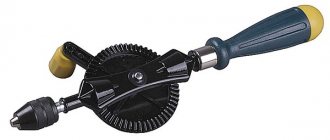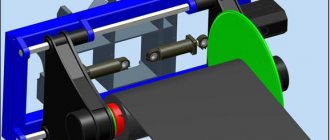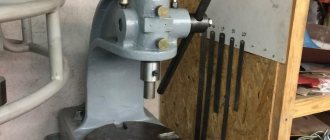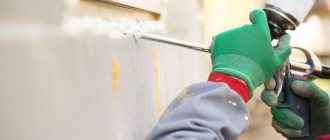Not every painting process takes place in convenient conditions with access to an electrical outlet. In situations where it is not possible to use a power tool, a completely autonomous manual mechanical spray gun, capable of providing effective spraying of water-based mixtures, comes to the rescue. Next, we will tell you how this amazing device functions and what work it is used for. We'll show you how to choose a reliable device and extend its service life with proper operation. And for the most pragmatic, we’ll show you how to make a hand-held spray gun with your own hands from household items. So, let's begin.
How does a manual spray gun work?
One of the most important advantages of a mechanical spray gun, in addition to autonomy, is its reliability due to the simplicity of its design. The device consists of a small number of metal parts and gaskets that are easily replaced when worn. A manual spray gun, unlike its pneumatic counterparts, operates on the principle of airless material supply. The sprayed mixture is pumped into the sealed housing of the device, from where it is pushed out by excess pressure created by a hand pump. All the main part of the work takes place in this building, and it consists of:
- Removable base with paint suction and pressure injection mechanism. There are 2 valves coming out of the base: for suction and liquid supply.
- A cylindrical body into which paint enters for subsequent passage through the discharge valve.
- A plunger pump with a handle located in the center of the above-mentioned housing, serving as the main drive of the entire structure.
In addition to the basic elements of the mechanism that provide the main part of the work, a manual spray gun will not function properly without special equipment. Any such device is supplied with 2 hoses: for suction and injection of liquid (the first is usually much shorter than the second). Spraying occurs using a special fishing rod with a trigger and a nozzle. In most models, the length of the fishing rod can be increased by screwing on additional sections. This is done for the convenience of painting ceilings or spraying tall trees.
All components of the mechanical spray gun design have threaded connections. Disassembling such a tool for cleaning, replacing gaskets or repairs is not difficult. It is worth noting that when assembling all connections, the threads should be lubricated with grease.
Painting stations
These are powerful devices capable of dispensing paint directly from a bucket. The spray gun and the paint pump itself are separated for these devices. When working, the operator holds in his hands a small paint gun to which paint is supplied under high pressure. The electric motor and pump are located on a separate platform.
The design of some devices includes wheels for more comfortable movement of the unit along with the paint. These spray guns have many adjustments. It is advisable to use them for large volumes of work on construction sites.
Where is it used?
A mobile device for effectively spraying liquid, capable of working anywhere using muscle power alone, can be very useful in many life situations. Perhaps a hand-held bullet gun is noticeably behind a specialized tool in terms of performance, but in certain circumstances there is nothing better than it. The scope of application is limited to spraying water-based solutions only and the imagination of the owner.
The primary purpose for the creation of a mechanical sprayer was painting. Since the tool has a fairly weak pressure (up to 5 atm), the quality of the applied layer is noticeably lower than that of pneumatic or electric analogues, but this is quite enough for upgrading utility and industrial premises. When using a manual spray gun for paint, you should remember that the device only works with water-dispersed mixtures (chalk, lime, emulsion).
In addition to painting, the device is successfully used in the treatment of various materials with fire protection agents.
You can also apply detergents and some types of glue with a hand spray gun. The second most popular area of application for the device can be considered private agriculture, where constant treatment of plants with various fertilizers and chemicals is required. In this case, we are talking not only about tall shrubs and trees, but also ordinary beds or potato fields. The convenient extension cord allows you to easily cover large areas without leaving your spot. A manual spray gun cannot be called a panacea for garden work, since there are more budget-friendly pump-action spray guns
.
As a not entirely obvious job, a hand-held spray gun can be used to wash a car, as a mobile, low-pressure analogue of a mini-wash (Kärcher). With this sprayer you can easily apply a soap solution and just as easily wash it off. Very useful when traveling outdoors.
Briefly about the main thing
The choice of spray gun should be based on the following points:
- For one-time work where quality is not important (whitewashing), it is better to use a mechanical device.
- To reduce material consumption, a plunger device is ideal.
- In a large farm or new building, when the device is expected to be used frequently, it is better to choose an electric spray gun.
- For professional purposes (car painting, painting), it would be more correct to purchase a pneumatic version using an external paint tank.
- Work in tight spaces requires the use of battery models with good autonomy.
Each user must decide which spray gun to choose based on the expected amount of work and personal budget.
Ratings 0
Rating of hand-held spray guns
Due to the total spread and reduction in cost of electric sprayers, the relevance of mechanical spray guns has noticeably decreased.
Today there are not many manufacturers left who can offer sufficiently high-quality products at an affordable price. It is not possible to find a manual mechanical spray gun in every large store, and these devices are often ordered online. It is impossible to check the reliability of such a transaction, so you should rely on the company’s authority and reviews. Below we have presented specific models of decent quality, in order of increasing cost. ULIG 050-00 (4400 RUR)
| Technical characteristics: Operating pressure – 5 atm Productivity – 230 m²/hour Mixture flow rate – 1.4 l/min Tank volume – 2.5 l Weight – 6.5 kg |
Zitrek CO-20 V (4800 RUR)
| Technical characteristics: Operating pressure – 4.8 atm Productivity – 220 m²/hour Mixture flow rate – 1.4 l/min Tank volume – 2.5 l Weight – 6.8 kg |
KSOM KRDP-4 (4900 RUR)
| Technical characteristics: Operating pressure – 5 atm Capacity – up to 250 m²/hour Mixture consumption – 1.40 l/min Tank volume – 2 l Weight – 5.3 kg |
If you find a hand-held spray gun on the market or in a store, before purchasing it, pay attention to the following features:
Stability.
The center of gravity should be evenly distributed and concentrated at the bottom of the device.
The total weight should be small (no more than 7 kg). Metal body.
Must be made of high-quality alloy that is resistant to corrosion and deformation.
Equipment.
In addition to the main container for pumping liquid, the spray gun should be supplied with 2 hoses (sleeves) with fasteners, a filter, a fishing rod with 2-3 sections and a nozzle. It would be good if the kit included several nozzles of different sizes and a set of spare gaskets that require frequent replacement.
Operation and cleaning
Despite the relative simplicity of the design, working with a mechanical spray gun includes several important nuances that must be observed. To save yourself from unnecessary inconvenience, get a more or less even coating and extend the life of the sprayer, you should adhere to the following rules:
- Before starting work, check the tightness of the container and the proper operation of the mechanism using ordinary water. This is more convenient, since if a leak or defect is detected, the device will need to be disassembled to replace gaskets or inspect the mechanism. If a mixture was pumped into the cylinder, it will have to be washed, and the water will only need to be wiped and dried.
- If a manual paint sprayer is used for its intended purpose - to apply paint, then it must be properly prepared. The essence of this activity is to dilute the mixture with ordinary or distilled water to the optimal consistency. Typically, mechanical devices spray compounds with a maximum viscosity of 20 din, i.e. very liquid. If there is no filter on the suction hose, the mixture must be filtered yourself, for example, through a nylon stocking.
Paint for a spray gun: how to dilute and determine viscosity Instructions for using a hand-held spray gun:
- We lower the liquid suction hose into the container with the spray composition and pump out about 0.5 liters from it.
- We take the hose out of the container and make about 8 more pumping strokes to force air into the container.
- Immerse the hose in the container again and make a few more back-and-forth movements of the pump rod to obtain the required pressure. For greater efficiency and maintaining the integrity of the components, the rod must be lowered and raised smoothly.
- Do not over-inflate the device under any circumstances. The maximum number of strokes is indicated in the device passport, in the “safety measures” section. Typically this value should not exceed 23.
- You can determine the optimal pressure using the spray torch. The pressure should have a cone shape and consist of tiny droplets.
- When the pressure decreases, it is necessary to perform several pumping cycles.
It is necessary to wash the mechanical spray gun immediately after use, before the mixture dries or reacts with the material of the body or fishing rod.
This is done very simply. As during operation, pump in 0.5 liters of water, pump in air, and release the fishing rod from the nozzle under pressure. The water follows the path of the previous mixture, washing away almost all remnants of its presence in the instrument. If you use a hand-held spray gun frequently (from 3 times a week), it is necessary to carry out monthly maintenance by lubricating the rod cylinder with machine oil. To do this, just unscrew the nut, add 10 drops, tighten it and make 5 reciprocating movements.
Criteria for choosing a tool for whitewashing
When choosing a spray gun, they are guided by the following criteria:
- Price. The most expensive are pneumatic models, the cheapest are electric. When making a paint sprayer with your own hands, the cost of materials will be minimal.
- Ease of use. The tool should be light, compact and easy to transport. The sprayer should be located on a long rod to facilitate the treatment of hard-to-reach places and surfaces located at high altitudes. This is especially important when whitewashing trees with a spray gun.
- Tank volume. For whitewashing large areas, it is advisable to choose a device with a large tank. The prepared solution should be enough to cover the entire surface area at one time. If you have to mix new portions of the solution several times during the work process, the coating may turn out to be uneven in color and thickness.
- Possibility of use in various conditions. Electric and pneumatic spray guns require a power source in the form of an electrical outlet. It may be difficult to operate these devices outdoors. Mechanical devices, on the contrary, can be used under any conditions.
- Uniformity of the jet exit from the nozzle. This factor is important to ensure uniform distribution of the solution over the treated surface. When using pneumatic devices, the pressure is maintained at a constant level using a compressor, and the jet comes out continuously. When working with manual paint sprayers, you must independently monitor the pressure and periodically increase it by pumping air in with a pump. Due to the gradual drop in pressure during operation, the solution stream is uneven. This affects the quality of the resulting coating.
- The quality of the resulting coating. The smoothest coating can be obtained when working with pneumatic devices. When using a hand spray gun for whitewashing, smudges and unevenness are possible.
- Device service life. It depends on the type of spray gun and the manufacturer. Mechanical devices are considered the most reliable, and electrical ones are considered the most short-lived.
- Possibility of repairing the spray gun. If individual structural elements break down, it should be possible to replace them with new ones.
DIY manual paint sprayer
Many people would like to have an autonomous device for effective liquid spraying, but the cost of such a device may not seem commensurate to its performance and ease of use. You can get a working manual paint sprayer for almost nothing, you can only make it yourself from inexpensive components.
The manual below demonstrates the process of assembling a spray gun, primarily intended for spraying liquid solutions. The diameter of the nozzle used in the assembly is not suitable for spraying water-based paints. However, a homemade system can always be upgraded by installing a brass nozzle from a small pump-action spray gun or a real hand-held spray gun. So, for assembly we will need the following components:
- Regular hand bottle sprayer (required as nozzle)
- Hose 8-10 meters, small diameter
- Sealed container (canister, bottle)
- Bicycle tube nipple with nut
- Ski pole, stem or straight branch as an extension
- Pump (preferably with a pressure gauge)
- Electrical tape and a tube of super glue
By instruments:
- Screwdriver with drills of different diameters
- Pliers
The assembly process is very simple and can be repeated by almost anyone, even without experience with tools. It is not necessary to follow the sequential steps, but we will present the instructions in the order of the author's narrative.
1.
We take a hand sprayer and glue its tube to the attachment point for a more reliable connection.
2.
We fix the trigger in the pressed position.
3.
We connect the end of the hose with the spray tube, inserting the second into the first. For a tighter fit, several layers of electrical tape should be wrapped around the tube.
4.
We wind the resulting structure to the extension cord.
5.
We make inlet and outlet holes for the container plug. If you use a regular bicycle tube nipple, use an 8 mm drill. We calculate the diameter of the hole for the hose ourselves. If the outer diameter of the hose is 9 mm, use an 8 mm drill for a tighter fit.
6.
Insert the nipple into the hole from the inside, securing it with a nut from the outside.
We thread the hose into its hole and pass it a short length, sufficient for its end to rest against the bottom of the container. 7.
For ease of carrying, a pump can be attached to the container. Or it can be connected as needed if the amount of work is small.
To get a clearer understanding of the assembly of a handheld spray gun, we strongly recommend that you watch the following video.
article from the Rating section
- 60
Hand tools Painting tools Garden tools
Save this page on your social media. network and return to it at any time.
ADD A COMMENT











